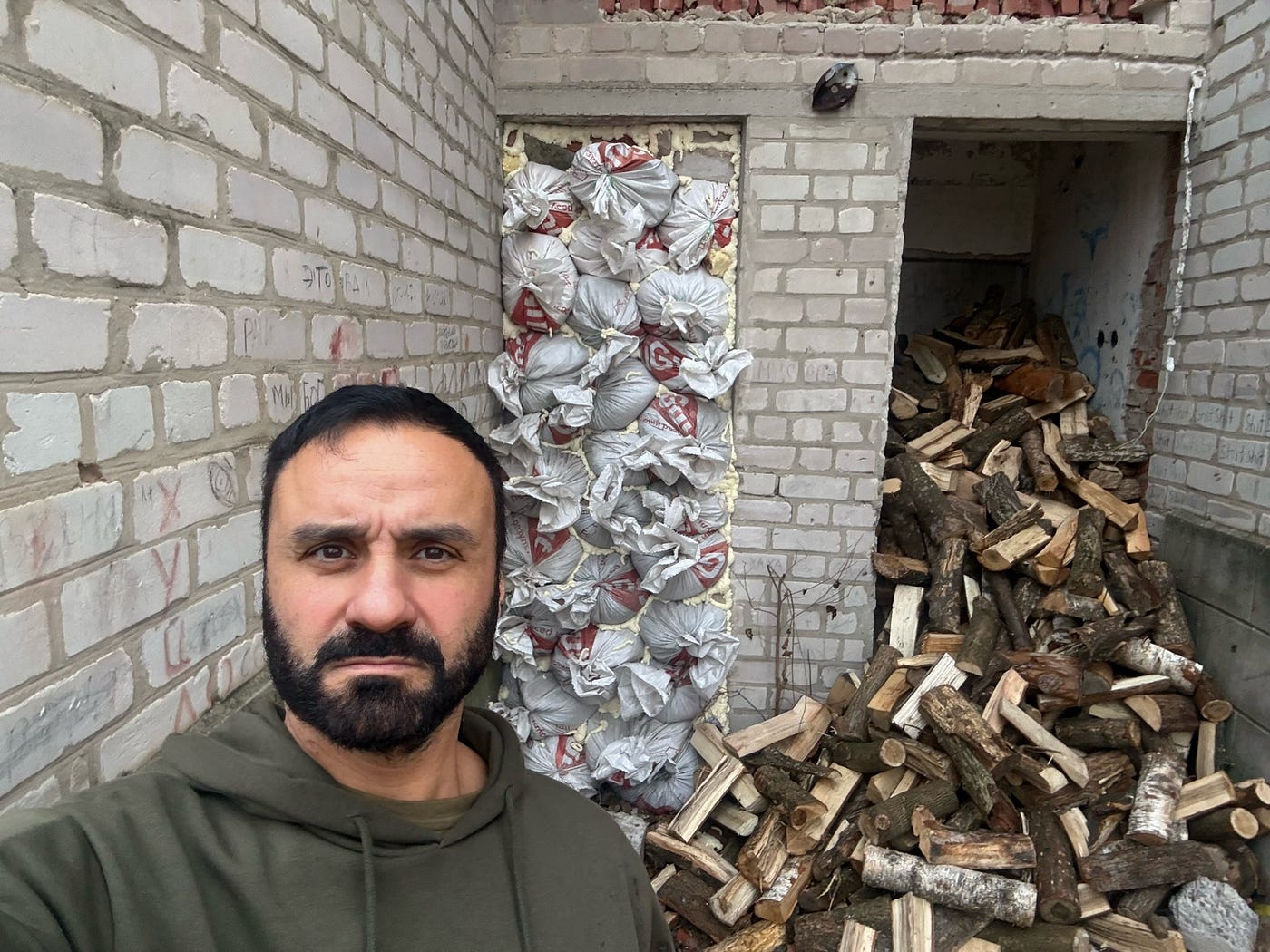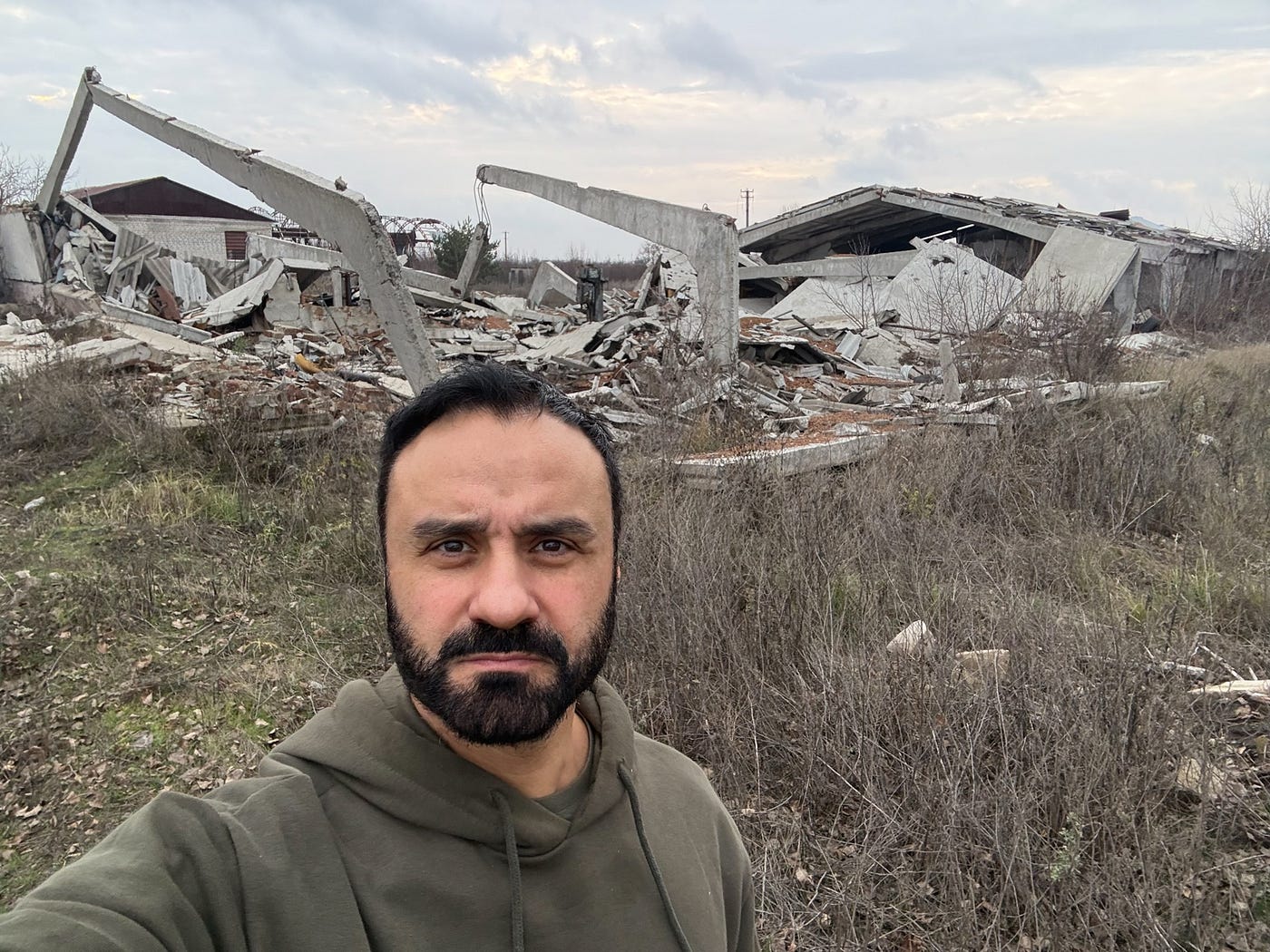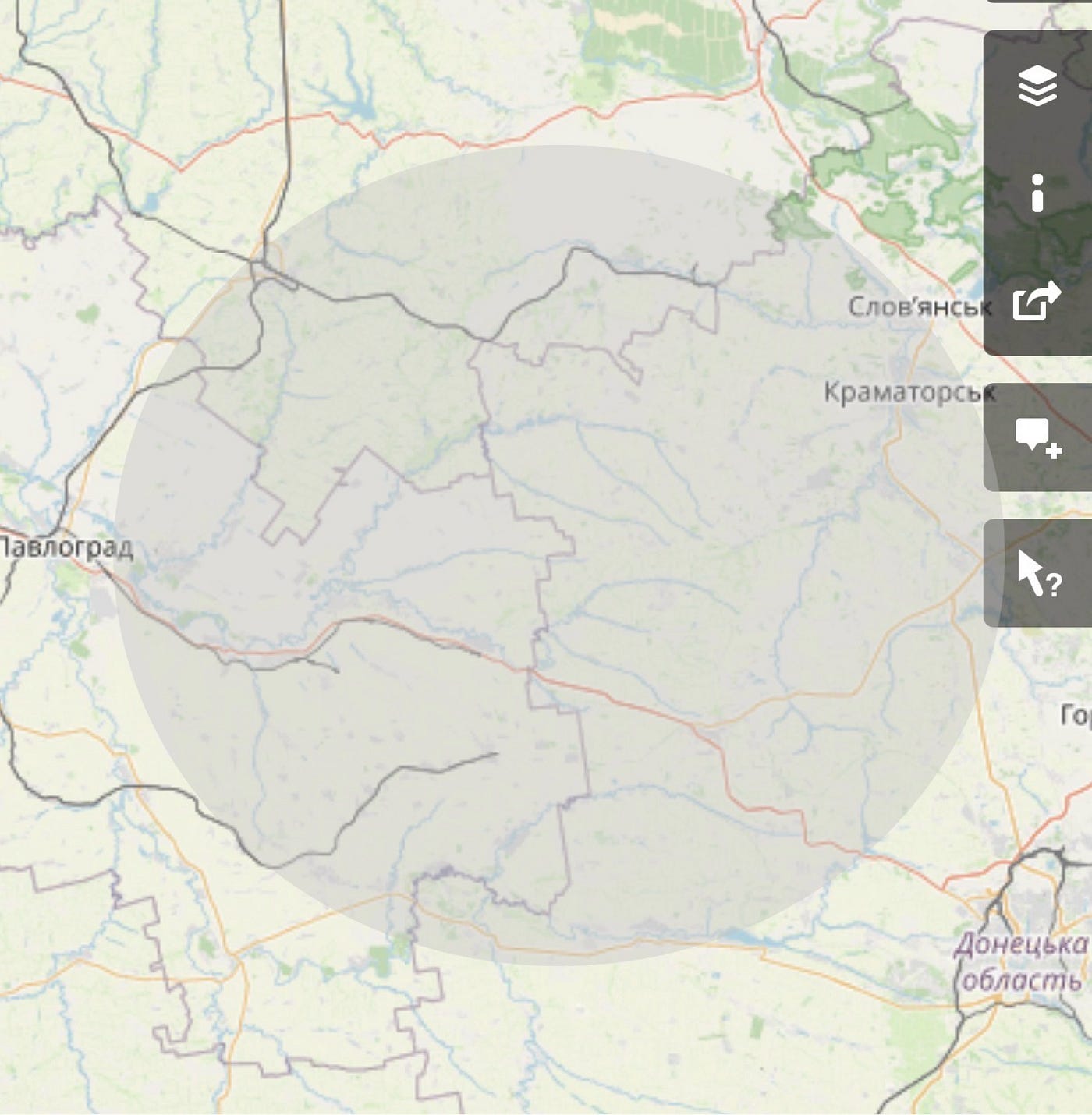Russian Troops Are Not Advancing On The Ground Technology Is
Russian Troops Are Not Advancing On The Ground. Technology Is.
By: Giorgio Provinciali
Nightmare Days and Nights in Kramatorsk
Live from Ukraine
Kramatorsk – Russian (i.e., Chinese) FPV drones now reach the city center and some parts of its western outskirts, making the civilian population seldom leave their homes. Essential activities are carried out by weaving close to the walls, constantly glancing skyward before rushing back into homes or shops. Storefronts and windows are boarded up with wooden planks and plywood, and dozens of ‘РЕБ’ anti-drone antennas can be spotted on the roofs of many cars – now even civilian ones. Although our press cars have been similarly equipped, today those jamming systems are no longer enough to defend against the lethal FPV drones. Russian terror, in fact, travels along thin fiber optic cables that many Chinese companies, without any shame, openly display on their marketplaces alongside the mortar rounds those kamikaze drones carry, clearly stating their purpose.
Intentionally targeted in this way, two Ukrainian journalists died last month at a gas station not far from where I am writing. A media worker accompanying them lost a leg, and two other Dutch reporters were saved at the last second by the good aim of a soldier accompanying them while recording a documentary inside a church destroyed by the Russian Federation in Druzhkivka. Attentive readers will recall that it was from those very locations in Donbas – just south of Kramatorsk – that I wrote the article preceding this one, reporting a desperate situation.

This is happening because, although Russian troops are not advancing on the ground, technology is. This makes areas far from the front uninhabitable, areas that would not have been so at risk with the conventional weapons with which this war began.
Over the past nearly four years, the evolution of these threats – now mainly electronically guided – has enabled the Russians and Ukrainians to intervene militarily, extensively and with extreme precision, in areas up to 50 kilometers from the front. This selective targeting accuracy, monitored until the last second by the operator of an FPV drone, leaves room to extend that range of terror for a fully autonomous system managed by the new UMPK modules that convert the old FAB glide bombs into deadly KABs. The Russians can now project up to three tons of explosives to areas as far as 200 kilometers from the launch point, whereas until recently, the operational range of those glide bombs was only 50.
It’s clear how devastated areas like those I recently reported on are. Druzhkivka, located 15 km south and 18 km east of the two main Russian salients, and Kramatorsk, about 20 km from the eastern one, bear the brunt. During each sleepless night in these places, I counted an explosion roughly every three minutes, coming from artillery, FPV drones, and glide bombs.

On the other hand, Ukrainians use ground drones that the Russians don’t have, which helps limit human casualties on the front lines. Traveling with soldiers from different brigades, I saw many of them in action, admiring their engineering skill both in person and through their cameras. Taking advantage of their lead over the enemy in this area, the defenders of Pokrovsk pushed the Russian forces back beyond the railway lines, effectively clearing them out house by house. Other drones provided valuable information from above, allowing those robots to complete their missions.
Those scenes are clearly visible from Ukrainian positions through the digital eyes of ground and air drones, just as I was able to witness live the rescue of a Ukrainian soldier by a robot that reached him, loaded him inside, and then protected him throughout the journey to the armored vehicle where he was then transferred for evacuation to the nearest field hospital.
The Ukrainians lack the volume of conventional firepower available to the Russians, but not their ingenuity or technological capabilities. Of the millions of North Korean bullets disbursed by the Pyongyang regime to Moscow, only a tiny fraction was supplied by the West to Ukraine.
Moving behind the lines, I saw shells being fired from XXXXXXX toward Pokrovsk. These shells traveled nearly 100 km, showing the potential is there, but the volume is insufficient. Due to its high mobility, Ukraine has lost less than 10% of its Caesar howitzers. It has Archer self-propelled artillery guns ready to fire, launching 21 rounds in three minutes, but it is short on ammunition.

Thanks to the use of indigenously developed glide bombs, the Ukrainian Armed Forces have succeeded in cutting off one of the main Russian supply routes behind Pokrovsk. Likewise, thanks to internal solutions, they have managed to completely isolate the occupiers in Kupiansk, leaving them with no choice but to surrender or face death. Although Russian propagandists claim otherwise, the reality on the ground remains clear.
Technological evolution has made even the maps used to depict ground conditions outdated, so much so that creating useful maps requires much broader color scales to show the intensity and speed of movement.
Now it’s up to Ukraine’s partners to be equally swift, so that their ingenuity and sacrifice aren’t wasted.
THANKS TO ALL WHO HELP US BUYING DRONE DETECTORS
感谢所有帮助我们购买无人机探测器的人!
幫我們購買無人機探測器
在過去的三年裏,作為自由撰稿人,我們一直在烏克蘭戰爭的所有前線進行報導,自從大規模…
https://www.paypal.com/pools/c/9k3lwAl8Wo
俄罗斯部队并未在地面推进,技术才是关键
作者: Giorgio Provinciali
克拉马托尔斯克的噩梦日夜
乌克兰前线报道
克拉马托尔斯克(Kramatorsk)——目前,俄罗斯(即中国)制造的FPV无人机已深及市中心及部分西部郊区,使得平民鲜少离开家门。人们在靠近墙壁的地方小心翼翼的进行必要的活动,时刻抬头警惕望天,然后迅速返回家中或商店。街面店铺及窗户被木板和夹板封堵,许多汽车车顶都装有“РЕБ”反无人机天线——甚至是民用车辆。虽然我们的新闻车也装备了类似的干扰设备,但如今这些系统已不足以抵御致命的FPV无人机。事实上,俄罗斯的恐怖活动依赖细小的光纤线,而许多中国公司毫不羞耻地在市场上公开展示这些光纤,旁边还放着这些神风无人机携带的迫击炮弹,彰显它们的用途。
上个月,因被(无人机)针对性袭击,两名乌克兰记者在距离我写作地点不远的加油站遇难。一名陪同他们的媒体工作者失去了一条腿,另外两名荷兰记者在德鲁日基夫卡一座被俄方摧毁的教堂内录制纪录片时,险些遇难,幸得一名随行士兵精准射击,才在最后一刻得以幸免。细心的读者或许还记得,我之前在克拉马托尔斯克南部的顿巴斯那些地区,就曾撰写过上一篇报道,描述那里非常危急的形势。
(图:我在顿巴斯的克拉马托尔斯克郊外——版权所有,Giorgio Provinciali)
这是因为,虽然俄军没有在地面上推进,但科技正在进步。这使得远离前线的地区变得无法居住,而如果使用这张战争开始时使用的传统武器,这些地方并不会如此危险。
在过去近四年中,随着威胁手段的演变——如今主要由电子导航控制——使得俄乌双方得以在距离前线最多50公里的范围内,进行大规模且极为精准的军事干预。由FPV无人机操作员实时监控的这种选择性精确打击,为由新型的UMPK模块控制的全自动系统扩展恐怖活动范围提供了可能,这些模块将旧式FAB滑翔炸弹转变成致命的KAB炸弹。俄罗斯现在可以向离发射点200公里远的区域投射多达三吨的炸药,而此前这些滑翔炸弹的投射范围仅为50公里。
很明显,像我最近报道的那些地区是多么的破坏殆尽。距离俄方两大突出点南部15公里,东部18公里的德鲁日基夫卡,和距东面突出点约20公里的克拉马托尔斯克,遭受冲击最为严重。这些地方的每一个无眠之夜,我计算过,大约每三分钟就会有一次来自炮火、FPV无人机和滑翔炸弹袭击的爆炸。
(图:俄罗斯“KAB”滑翔炸弹对乌克兰顿巴斯地区平民基础设施的破坏——版权所有,Giorgio Provinciali)
另一方面,乌克兰使用俄军所没有的地面无人机,有助于减少前线的人员伤亡。随着不同旅的士兵一同出行,我见证了他们的多次作战行动,既亲眼所见,也通过摄像头感受到他们的工程技术。利用在这一地区对敌人的优势,波克罗夫斯克的防御方将俄军逼退到铁路线以外,实质上逐屋清剿敌人。其他无人机从空中提供了宝贵的情报,使这些机器人得以顺利完成任务。
从乌克兰阵地,通过地面和空中无人机的数字“眼睛”,可以清楚看到这些场景,就像我亲眼目睹一名乌克兰士兵被一台机器人救援的全过程:它驶到士兵身边,将他装载其中,保护他直到被转移到装甲车上,随后送到附近的野战医院进行救治。
乌克兰人在传统火力方面不及俄军,但他们并不缺乏创造力和技术能力。平壤政权向莫斯科供应的数百万发子弹中,而西方向乌克兰提供的只是其的极少一部分。
我在防线后方看到,XXXXX正向波克罗夫斯克发射炮弹。这些炮弹射程接近100公里,显示出潜力已足,但数量还远远不够。由于拥有高度机动性,乌克兰目前损失的“凯撒”榴弹炮不到10%。乌克兰还部署了“弓箭”自行火炮,能够在三分钟内发射21发炮弹,但弹药库存不足。
(图:我决定发布一份较少细节的地图版本,旨在防止敌人获取宝贵信息——原地图由OpenStreetMap提供)
得益于自主研发的滑翔炸弹,乌克兰武装部队成功切断了波克罗斯克后方的一条主要俄军补给线。同样,凭借内部技术方案,他们已设法完全隔离了库皮扬斯克的占领军,迫使其别无选择,只能投降或面对死亡。尽管俄方宣传者声称情况并非如此,但地面形势依然清晰明了。
科技的不断发展使得用于展现地面状况的地图也变得过时,绘制有效的地图已需要更广泛的色标,以反映移动的强度和速度。
现在,乌克兰的盟友们也需要同样迅速行动,才能确保他们的智慧和牺牲不被白白浪费。
